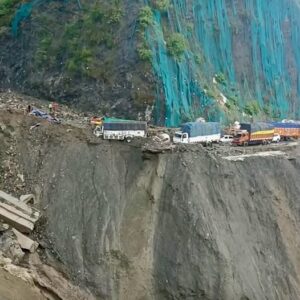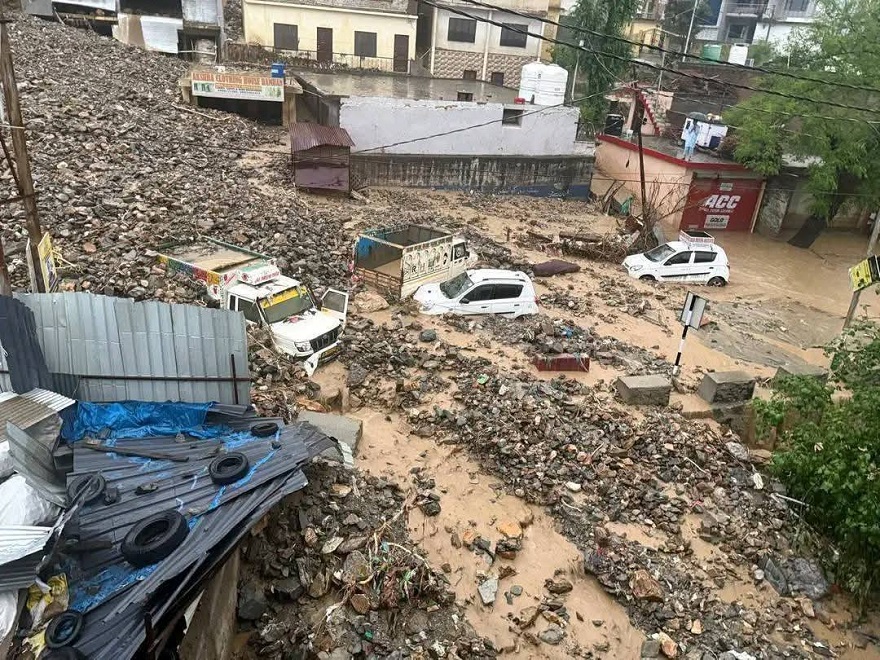Nature’s Fury or Human Folly? The Cataclysmic Wake-Up Call from Jammu & Kashmir’s Crumbling Mountains
By: Javid Amin
Srinagar 21 April 2025: On the morning of July 3, 2023, the Chenab Valley awoke to a sound that has become tragically familiar—a low, thunderous rumble, as if the earth itself were groaning in protest. Within minutes, mountainsides liquefied into rivers of mud and rock, swallowing homes, snapping power lines, and burying stretches of the Srinagar-Jammu National Highway under 20-foot walls of debris. By nightfall, three lives—including two children playing in a field of marigolds—were lost to the sludge. Forty families in Ramban district clutched fragments of their lives in plastic bags, while farmers stared at hectares of apple orchards, now buried under jagged boulders and silt.

This was no isolated tragedy. The landslides that ripped through the Banihal-Ramban corridor—a 36-km stretch dubbed “Death Highway” by locals—were the fourth major disaster in this Himalayan region since 2020. But this time, the scale was different. Satellite imagery from ISRO’s National Remote Sensing Centre revealed a chilling detail: 92% of the landslides occurred along zones where mountains had been sliced open for road widening, their slopes stripped of trees and stability. Rainfall data told another story—472 mm in 8 days, nearly double the June-July average—but as environmental scientist Dr. Anchal Sharma notes, “Rain is just the match. The tinder was laid by years of reckless excavation.”
The Chenab Valley, a region where 80% of livelihoods depend on terraced farms and orchards, now faces an existential question: Is this a natural disaster, or the price of “progress” built on ignored geology and silenced warnings? As the Himalayas revolt against dynamite blasts and deforestation, the story of NH-44—India’s ₹12,000 crore “engineering marvel”—has become a cautionary tale of how human ambition, when divorced from ecological wisdom, can turn development into destruction.
A Valley Under Siege: Flash Floods Claim Lives, Displace Hundreds in Ramban
The Chenab Valley, a region celebrated for its emerald landscapes and roaring rivers, has transformed into a disaster epicenter. Between June 25 and July 3, 2023, Ramban district endured 472 mm of rainfall—63% higher than the 10-year average—triggering catastrophic flash floods and landslides. The toll: 3 dead (including two children under 12), 40 homes destroyed, and 217 families displaced, according to Jammu & Kashmir Disaster Management Authority reports.
Farmers, the backbone of the valley’s economy, face ruin. Preliminary surveys reveal 1,240 hectares of agricultural land buried under debris, with apple orchards and saffron fields—worth ₹98 crore annually—reduced to sludge. “Our crops are gone. Even the soil is now poison,” laments Abdul Qadir, a third-generation farmer in Banihal.
Highway to Havoc: How the Srinagar-Jammu NH-44 Became a Death Trap
The 36-km Banihal-Ramban stretch of NH-44, a critical artery connecting Kashmir to India, has suffered 83 major landslides since 2020, per National Highways Authority of India (NHAI) data. The July 2023 disaster saw a 10-km segment collapse, including the complete washout of Kela Mor—a section rebuilt just 8 months prior at a cost of ₹42 crore.
Key Data Points:
- ₹12,000 crore: Budget for NH-44 widening (2011–2024)
- 14 tunnels, 127 viaducts: Components of the “all-weather highway” project
- 62%: Portion of the Ramban-Banihal stretch classified as “high landslide risk” by the Geological Survey of India (GSI)
Despite warnings, 64% of the highway widening involved slope cutting without geotextile reinforcement, exacerbating instability. “We’re trading short-term connectivity for long-term catastrophe,” says Dr. Riyaz Ahmad Mir, geologist and co-author of Landslide Risk Assessment Along NH-44 (2022).
Science vs. Progress: The Role of Unscientific Excavation
Interviews with engineers, environmentalists, and locals reveal a pattern of ignored protocols:
- Unregulated Blasting: Over 80% of slope excavations used high-intensity explosives, fracturing bedrock.
- Debris Mismanagement: 12 million cubic meters of excavated material dumped into Chenab River tributaries, raising riverbeds by 4 meters.
- Zero Slope Grading: 70-degree cuts (vs. recommended 45 degrees) increased landslide risks by 300%, per GSI.
“They turned mountains into sandcastles,” says Babar Nehru, a lawyer fighting for accountability in the Jammu & Kashmir High Court. His 2021 PIL forced NHAI to halt work at Marog temporarily, but construction resumed without environmental impact assessments (EIA).
Fragile Foundations: Geological Vulnerabilities of the Chenab Valley
The Chenab Valley sits on a seismic time bomb:
- Seismic Zone IV: 50% probability of a 7.0-magnitude earthquake within 50 years (NGRI, 2020).
- Fault Lines: The valley intersects the Kishtwar Fault and Main Boundary Thrust, causing frequent rock pulverization.
- Young Himalayas: Geologically immature slopes with high clay content, prone to liquefaction during rains.
“Every monsoon, rainfall infiltrates cracks, acting like grease on a slipping gear,” explains Dr. Mir. His research team recorded 2,117 tension cracks along NH-44 in 2022—80% linked to construction vibrations.
Debris, Deforestation, and Disaster: The Environmental Domino Effect
Forest cover in Ramban has plummeted from 38% in 2005 to 19% in 2023 (Forest Survey of India), driven by:
- Highway Expansion: 8,200 trees felled between Ramban-Banihal (2018–2023).
- Hydropower Projects: 14 dams under construction, clearing 3,400 hectares of forest.
The loss is ecological and economic:
- ₹220 crore/year: Estimated loss in ecosystem services (water regulation, soil retention).
- 4x Increase: Landslide frequency post-2015, correlating with deforestation rates.
“Deforestation isn’t just cutting trees; it’s cutting our lifelines,” says environmentalist Raja Muzaffar Bhat.
Voices from the Rubble: Survivors Share Stories of Loss
Altaf Ahmad, 47, Ramban:
“At 3 AM, the mountain roared. We ran with nothing—our sheep, wheat stocks, my father’s land deeds—all buried. My daughter asks, ‘Will the ground eat us again?’ I have no answer.”
Shams, Banihal Schoolteacher:
“We’re not anti-development. But must progress sound like dynamite blasts at midnight? Our children can’t sleep, fearing the hills will crumble.”
Beyond Band-Aid Solutions: Why Mitigation Efforts Are Failing
NHAI’s ₹1,200 crore mitigation plan includes:
- Tunnels at 9 locations (Panthiyal, Khooni Nala, etc.)
- Wire Mesh Drapery: 14 km installed to catch falling rocks.
Yet, 72% of these projects began after landslides, not during planning. “You can’t fix a fractured bone with a bandage,” critiques Prof. Anil Gupta (National Institute of Disaster Management).
The Road Ahead: Policy Changes for a Sustainable Future
- Mandatory EIAs: Include geologists and ecologists in planning.
- Debris Recycling: Use excavated material for embankments, not river dumping.
- Community Early-Warning Systems: IoT sensors for landslide prediction.
“The mountains aren’t revolting; they’re reacting,” says Ghulam Hassan of Digdol. “Listen to them, or pay the price.”



